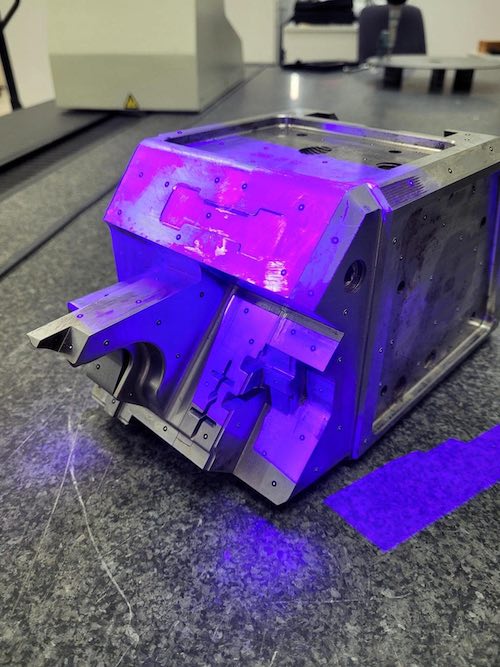
WEBINAR: Unlock the Power of Industrial CT Scanning
See Deeper. Solve Faster. Spend Smarter.
A 1/2 Hour That Could Reshape Your Inspection Strategy
Date: Wed June 18, 2025
Time: 11am Central Time
Location: Live Online Webinar

See Deeper. Solve Faster. Spend Smarter.
A 1/2 Hour That Could Reshape Your Inspection Strategy
Date: Wed June 18, 2025
Time: 11am Central Time
Location: Live Online Webinar
Extract design intent from existing parts with data gathering methods that are highly accurate and repeatable.
Get a simple-solid model or take it further to get a fully-parametric CAD model.
No CAD data? No problem. Rebuild a parametric model from scratch or get all design tree information for editing.
Some of these include:
As the 3D scanning reverse engineering industry evolves, other cutting-edge, extremely accurate systems are emerging. Industrial CT scanning and blue light scanning are two such technologies Nel PreTech has mastered.
This is typically a preprocessing step to get ready for the third step of creating a 3D CAD model. For others, this may be the final step. For customers interested in data analysis, or rapid prototyping with their own internal CAD department, this step may be all that is needed.
The raw data from step 1 is processed and used to create a polygonal .STL model. For those customers who require a solid .STEP conversion of the .STL data set, further mesh editing/processing of the .STL may be needed.
Rapid Surfacing/quick-wrap method: As mentioned in step 2, the option to convert the polygonal .STL file to a solid .STEP file is available. This is typically the least costly and fastest method of creating a CAD model.
Our reverse engineering software takes the STL model from the previous step and shrink wraps a surface over the entire STL model. The result is a completely surfaced model that matches the scanned part exactly. All imperfections such as warp, parting lines, flash, etc. are captured.
The surfaced model can then be exported in an IGES or STEP format for further processing in other CAD software packages. This method produces a solid model that is a simple solid conversion of the polygonal .STL file. No parametric information is contained in the file.
Data from step 1 and step 2 can be combined and used as design templates to rebuild a parametric model from scratch.
Fully parametric models can also be produced and provided in a native Solidworks format.
Luers, Drug Delivery, Medical Implants, Dental Hardware, Medical Connectors
Electric Vehicles, Batteries, Farming & Mining Equipment, Recreational Vehicles, Marine
Manifolds, Pumps, Nozzles, Electronics
Packaging, Disposable Cutlery, Sporting Goods, Tech Manufacturing
Die Casting, Metal Stamping, Plastic Injection Molding, Metal Injection Molding
3D Printing, Rapid Prototyping, Direct Manufacturing, Tooling
Firearms, Weapons Systems, Hypersonics, Ammunition
Establishes:
You'll find all the detailed service information you need in one brochure.
Download Brochure
A manufacturer and supplier of industrial scale food processing blades needs to manufacture a part in the U.S. They need a 3D CAD model to work from.
3D scan to cad using Geomagic Design X
Client gains a .step model which can be opened and read universally across all CAD/CAM software packages. They also save money by manufacturing the part in the U.S.

Major sporting goods manufacturer needs a CAD model built using scan data from an existing golf club.
3D scanning and mesh editing in specialized CAD modeling software to remove features.
Client saves time with our quick turnaround and develops a new product with our accurate 3D SCAN TOCAD services.

Global OEM medical device company needs help developing and launching drug delivery pumps.
CT scanning and value-add services create a turnkey solution to give the client a competitive advantage.
20 new tools in 20 weeks.
There are a variety of technologies used to acquire x, y, z coordinates of a real-world object. If you choose to work with Nel PreTech, you’ll find we employ the newest 3d scanning technologies. Talk to our experts to find the appropriate fit for your 3D scan to cad application.




Getting to know the customer, the part, and intended use of the 3d scan data we provide helps us determine the best delivery method for your objectives. To learn more about our 3d scanning deliverables read: Engineered Formats & Outputs for 3D Scanning Services.
Four Key Outputs:

Download the ultimate CT Scanning Buyer's Guide to improve understanding, time, and efficiency in your scanning needs. Over 50 Pages of useful data and case studies.
Download Now